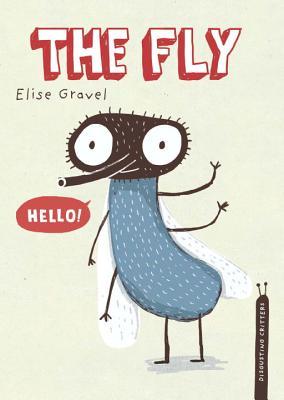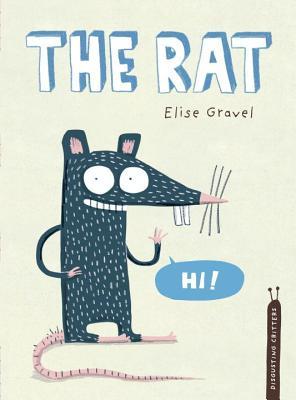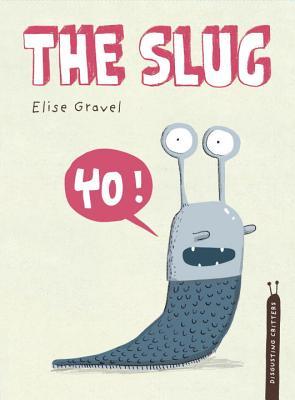Showing posts with label nonfiction should be fun. Show all posts
Showing posts with label nonfiction should be fun. Show all posts
Wednesday, September 07, 2016
My New Favorite Nonfiction Series
Welcome to my new favorite nonfiction series, the Disgusting Critters series, or, as originally published in French, Les petits dégoûtants.
You can see that I tagged these books "nonfiction should be fun." Along with information about the critters' bodies, eating habits, and all the nasty things they do, each book also contains off-the-wall comments by the narrator and the critter, and delightfully goofy illustrations.
Franki texted me, "Your nonfiction post that I sneaked a peek at just cost me $37.00." These books are perfect for third grade. I checked out the whole series from the library and will read one to my fifth graders for #classroombookaday (the one they vote as the most disgusting critter), and then I will keep them in the room for a couple of weeks.
That's what I'm thinking right now, but based on my students' response, this post might cost ME $37.00, too!
Labels:
humor,
nonfiction,
nonfiction should be fun,
series
Wednesday, December 11, 2013
Stamina in Nonfiction Reading
Locomotive
by Brian Floca
Atheneum/Richard Jackson Books, (September 3, 2013)
Review copy from the public library, but I have a feeling I'll be buying this one!
Don't you hate it when the perfect book for one of your social studies standards comes out the year after they change your standards? ARGH!
I struggled to find ways to make the Transcontinental Railroad accessible to urban 5th graders, most of whom had never traveled out of the state, let alone across the country by any means of transportation, and who had never seen a train, let alone a steam engine, up close.
Well, just because the Transcontinental Railroad is no longer in our social studies standards doesn't mean I can't use this book as a part of our nonfiction unit.
One of my goals for my students in this unit is that they will build stamina for reading longer and longer nonfiction. One of my goals for read aloud this year is that I'll actually DO what I've said I would do for years now -- integrate nonfiction read alouds.
This is the perfect book to support both goals.
We will study the endpapers -- the maps in the front and the diagram of a steam engine in the back -- using the document camera.
The poetic text filled with the sounds of the train will draw us in and keep us going.
We will read the notes in the back (even though there are a lot of small words on the page), maybe even doing a close reading to fuel a discussion of cause/effect, compare/contrast, and "what next?" (another goal for this nonfiction unit is that my students will find topics and authors that lead them from one nonfiction book to the next).
Here's a great video on the history of steam trains to watch before or after reading the book:
Here's a great video on the history of steam trains to watch before or after reading the book:
Thursday, December 05, 2013
Thankful For the Public Library!
The first thing you notice when you walk into my room is the books -- six shelves there (with tubs across the tops of all of them), a homemade cinderblock and plank shelf there, two tall ones there, two short ones under the chalk tray there, the one behind the small table that serves as my desk...books are everywhere.
And yet, as I worked on the details of how I would approach the nonfiction unit we were set to start this week, the details about what other kinds of learning I was going to aim for beyond the standards that guided our planning, I realized I didn't have enough nonfiction books.
Praise be for the ability to place reserves online!
Praise be for TWO library cards -- a citizen card plus an educator card!
I have 17 different volumes in the Scientists in the Field series
I have 22 books by Steve Jenkins
I have 9 books by Don Brown checked out (this is his newest
(If it feels like I'm stopping this post without fully explaining everything -- like I did with my word study choice time post yesterday -- blame #nerdlution. This is my 30 minutes to write and if I don't stop now, I won't get showered and a lunch made and to school on time! At least this one is better edited than yesterday's [I hope]. I'm planning to update the word study choice post with information that answers some of the questions in the comments. What else are you wondering about our nonfiction study?)
Tuesday, November 13, 2012
Visuals in Nonfiction
I See What You Mean: Visual Literacy K-8
by Steve Moline
Stenhouse, 2011
It is definitely going to be worth the two weeks we spent in reading workshop looking at the structures of nonfiction (description, sequence, compare/contrast, cause/effect) and in writing workshop looking at and trying out the visuals that support those structures. There's an excellent chart in Moline's book that we have used as a reference guide over and over again. He gives examples of diagrams and maps (description), timelines and flowcharts (sequence), tree diagrams and Venn diagrams (compare/contrast).
I knew it was going to be worth the time when, as we discussed the Poetry Friday Anthology poem of the week last Friday, someone said, "That poem's a sequence." YES! And when the new copy of American Girl magazine came, and the three readers brought it to me to say, "Look! Here's a diagram!" And then, of course, when the new Scaredy Squirrel came, we found nearly EVERY kind of visual we had studied!
Don't you love it when that happens?!?
by Mélanie Watt
Kids Can Press, 2012
Here are pictures of our hallway display and some of the students' work. They had a lot of fun with this. As you see, they could use their life and their interests. I'm hoping that when we do more nonfiction writing, they remember that they don't need to do research to write nonfiction!
 |
| Some of the students had lots of fun with expanded/exploded diagrams. |
 |
| (see map of Snoopy's Doghouse below -- this diagram goes with that map!) |
Wednesday, September 05, 2012
BAFFLING AND BIZARRE INVENTIONS by Jim Murphy
Sally Oddi at Cover to Cover shared this new, fun Nonfiction book with me-Baffling & Bizarre Inventions by Jim Murphy. This book is fun and one that can be revisited over and over. The book is in a multiple-choice/quiz format. Each page gives the reader an illustration of a bizarre invention, a little piece of information and 4 choices of what the invention is. When you turn the page, you see the correct answer, along with a few paragraphs about the information. This may include the reason for the invention, info on how the invention worked,
by Jim Murphy. This book is fun and one that can be revisited over and over. The book is in a multiple-choice/quiz format. Each page gives the reader an illustration of a bizarre invention, a little piece of information and 4 choices of what the invention is. When you turn the page, you see the correct answer, along with a few paragraphs about the information. This may include the reason for the invention, info on how the invention worked,
The title definitely fits this book. Every time I sit down with it, I open to a random page and am amazed at the invention shared.
This is a fun book and kids will have fun reading it alone or with friends. It would also make a great short read aloud for classrooms. During those 5 minute times between activities or when lining up for lunch, kids will love making a guess and learning about one of these inventions. It won't take much to get kids hooked on this book
The title definitely fits this book. Every time I sit down with it, I open to a random page and am amazed at the invention shared.
This is a fun book and kids will have fun reading it alone or with friends. It would also make a great short read aloud for classrooms. During those 5 minute times between activities or when lining up for lunch, kids will love making a guess and learning about one of these inventions. It won't take much to get kids hooked on this book
Friday, December 30, 2011
Poetry Friday -- Presidential Edition
The President's Stuck in the Bathtub: Poems about the Presidents
by Susan Katz
illustrated by Robert Neubecker
Clarion Books, on shelves February 8, 2012
review copy provided by the publisher
Since 2012 will be a presidential election year, it seems appropriate to start brushing up on our presidential facts and trivia sooner, rather than later.
In this book, every president gets a poem based on sometimes a little-known and sometimes a well-known fact about his presidency. The fact is elaborated briefly at the bottom of the page. There is more information about each president in the back of the book, but it is as bite-sized and kid-friendly as each president's page -- you get dates of the term(s) served, birth/death dates, a quote, the president's nickname, and that president's "first."
I love the poems in this book. Here's an example that highlights one of the most infamous of the eight Ohio Presidents:
The Long and Short of It
(William Henry Harrison, 1841)
Without a hat or gloves or overcoat,
William Henry Harrison stood in driving rain
on the Capitol's east steps to declaim to a crowd
the longest, most meandering inaugural address
of any president in history, 3800 words or so,
that took almost two hours to deliver. That was long.
Harrison
was only
president
one month.
That
was
short.
William Henry Harrison's election campaign was longer than his presidency. He caught a cold at his inauguration and a month later died of pneumonia.
© Susan Katz, 2012
So, yes, I love the poems, but I also love how the facts at the bottom of each page elaborate or illuminate the poem in some way.
And if there isn't already enough to love about this book, I can't wait to read through the presidential notes and quotes with my students to give them an interesting snapshot history of the United States. Here are a few examples that stopped me in my tracks and made me think:
Julie Larios has the Poetry Friday roundup today at The Drift Record. Seems she has politics on her mind, too!
by Susan Katz
illustrated by Robert Neubecker
Clarion Books, on shelves February 8, 2012
review copy provided by the publisher
Since 2012 will be a presidential election year, it seems appropriate to start brushing up on our presidential facts and trivia sooner, rather than later.
In this book, every president gets a poem based on sometimes a little-known and sometimes a well-known fact about his presidency. The fact is elaborated briefly at the bottom of the page. There is more information about each president in the back of the book, but it is as bite-sized and kid-friendly as each president's page -- you get dates of the term(s) served, birth/death dates, a quote, the president's nickname, and that president's "first."
I love the poems in this book. Here's an example that highlights one of the most infamous of the eight Ohio Presidents:
The Long and Short of It
(William Henry Harrison, 1841)
Without a hat or gloves or overcoat,
William Henry Harrison stood in driving rain
on the Capitol's east steps to declaim to a crowd
the longest, most meandering inaugural address
of any president in history, 3800 words or so,
that took almost two hours to deliver. That was long.
Harrison
was only
president
one month.
That
was
short.
William Henry Harrison's election campaign was longer than his presidency. He caught a cold at his inauguration and a month later died of pneumonia.
© Susan Katz, 2012
So, yes, I love the poems, but I also love how the facts at the bottom of each page elaborate or illuminate the poem in some way.
And if there isn't already enough to love about this book, I can't wait to read through the presidential notes and quotes with my students to give them an interesting snapshot history of the United States. Here are a few examples that stopped me in my tracks and made me think:
- We were 8 presidents in before we had the first president born an American citizen. (Martin Van Buren)
- Jimmy Carter, president number 39, was the first president born in a hospital. (how could that BE?)
- It took 16 presidents before we had one who had been born outside the original thirteen colonies. (Abe Lincoln)
- And president #34, Dwight D. Eisenhower, was the first president of all fifty states.
Julie Larios has the Poetry Friday roundup today at The Drift Record. Seems she has politics on her mind, too!
Labels:
nonfiction should be fun,
Poetry Friday,
presidents
Wednesday, November 19, 2008
Ask Dr. K. Fisher about Creepy-Crawlies
 Ask Dr. K. Fisher about Creepy-Crawlies
Ask Dr. K. Fisher about Creepy-Crawliesby Claire Llewellyn
illustrated by Kate Sheppard
first published in Great Britain
published in the United States, coincidentally, by Kingfisher, an imprint of Henry Holt, 2008
review copy provided by the publisher
Yesterday we met a caterpillar with all kinds of personality; today we meet Dr. K. Fisher, a bird who answers all kinds of questions put to him by all kinds of creepy-crawlies. There's a scorpion who is counseled by Dr. K. Fisher not to go around wasting his venom on gratuitous stinging, an earthworm with body image problems, a bashful glowworm, and more. Interspersed between the question and answer letters are guides to creepy crawly bodies, insect wings, insect disguises, and insect colonies. Included are a glossary and an index.
Wouldn't this make a great mentor text for a fun way to write a nonfiction piece -- as letters to and from an expert on the subject you've researched?
Also in the Ask Dr. K. Fisher series -- dinosaurs, animals, reptiles, and coming in 2009 -- weather!
Monday, November 10, 2008
The Snow Show: With Chef Kelvin
 The Snow Show: With Chef Kelvin
The Snow Show: With Chef Kelvinby Carolyn Fisher
Harcourt, 2008
review copy provided by the publisher
Carolyn Fisher got the memo that science should be fun.
The Snow Show is a TV cooking show and the reader is in the audience for the episode where they make snow. As with any recipe, you start with your "ingredients: (available in your better latitudes) sun, water, wind, specks of dust, heat, cold." Next, the directions take you through the water cycle, the formation of snow crystals, and the assembly of a snowman, all with illustrations that explain and entertain.
Along with the fun, the reader gets a giant helping of great vocabulary, like (new one to me) DEPOSITION -- when vapor turns to ice without turning into a liquid, and some scientific equations for phase changes, like the one for freezing: liquid - heat = solid (ice).
A must-have for your weather unit. Especially this time of year!
Here is Carolyn Fisher's website, where you can get a free activity kit to go with THE SNOW SHOW. The activities range from easy to expert -- from seasonal to scientific.
Sunday, November 09, 2008
How Fast Is It?
 How Fast Is It? A Zippy Book All About Speed
How Fast Is It? A Zippy Book All About Speedby Ben Hillman
Scholastic, 2008
I bought it. Had to have it.
If you are a fan of How Big Is It? and How Strong Is It? you are going to have to buy this book.
Same great pictures that say almost as much as the words, same great text that grabs you and makes you want to read:
Birds Gotta Swim, Fish Gotta FlySome animals don't do as they're told. Birds are supposed to fly. Fish are supposed to swim. Now meet the penguin and the flying fish. They've turned the rules topsy-turvy.Coyote vs. RoadrunnerYou may be surprised to learn that some television cartoons show events that have nothing at all to do with reality! But before you throw down this book and start writing an indignant letter to the television networks, let's see how bad it really is.ComputerThe fastest computer in the world is that small, squishy blog of glop inside your head.
Those are a few of my favorite leads. Hillman is a master of endings, which I think are even harder to write:
Even teenagers don't grow that fast.You might wonder if you can really use a sneeze to gain an advantage over your tennis opponent. You could, but please don't. It's not polite. And just to be safe, cover your mouth when you sneeze. Please."And if you make me explain relativity theory one more time, I'm stopping this bus!"
Subscribe to:
Comments (Atom)


































